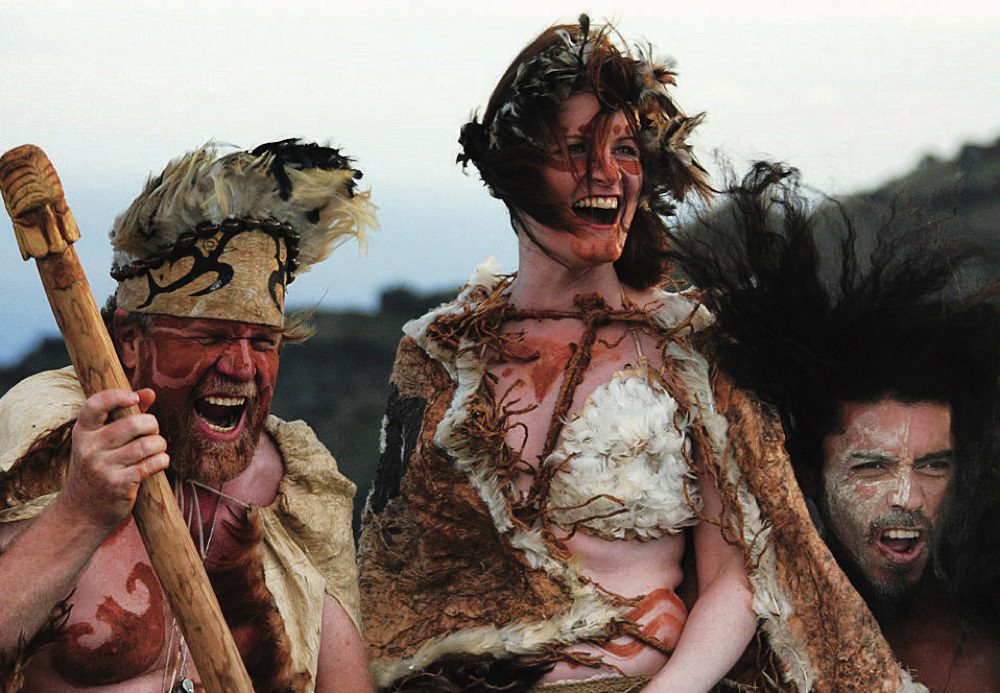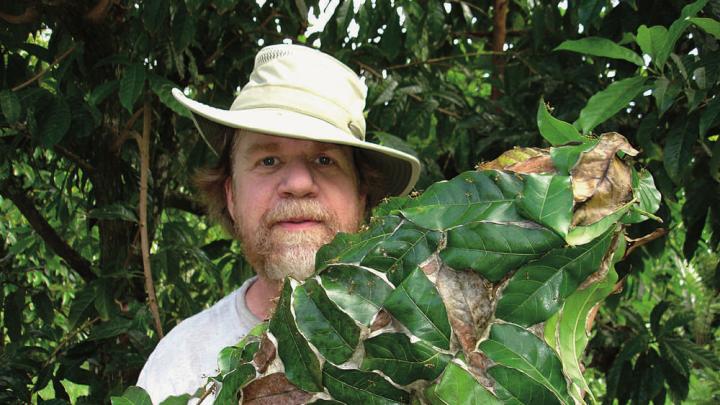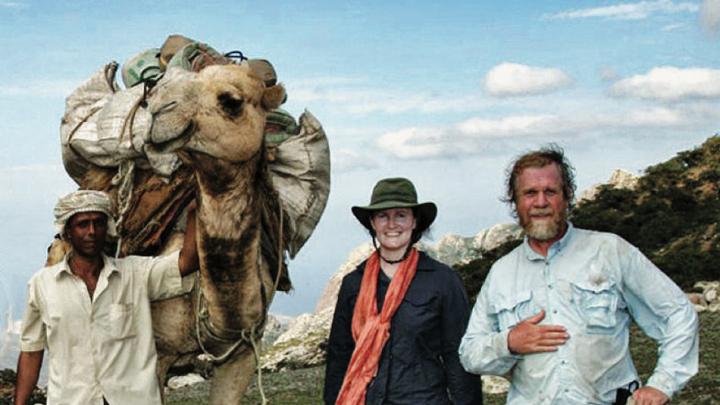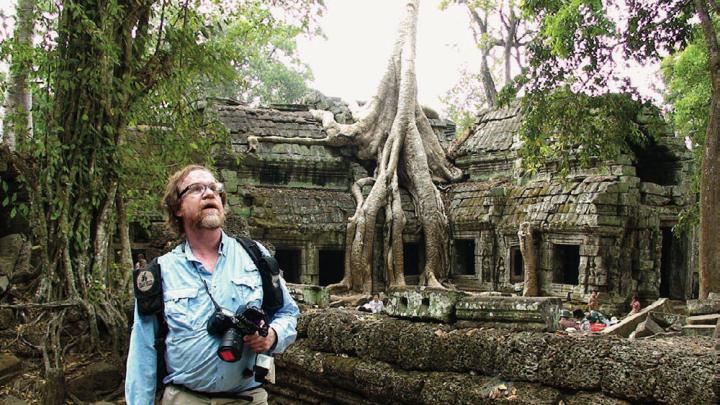Tromping through a Peruvian rainforest looking for ants, Mark W. Moffett, Ph.D. ’87, accidentally sat on a deadly fer-de-lance pit viper. In Sri Lanka, Kenya, and India, he barely escaped stampeding elephants. Then there was the time in Colombia, while tracking the world’s most toxic frog (Phyllobates terribilis), that Moffett ended up armed with a poisonous tribal blow gun in a stand-off against drug smugglers. “Well, it’s a long story,” he says, nearly chuckling at the memory. “Eventually, a military escort pulled us out and got us to the airport.”
By rights, the enterprising tropical biologist, a former graduate student of Pellegrino University Professor emeritus E. O. Wilson, should be dead. Many times over. Instead, his energy and oddly wide-eyed innocence have backstopped an eclectic career as an award-winning explorer, speaker, writer, and photojournalist. He travels at a moment’s notice, beholden to no one and nothing except his own desire to get up close to the creatures he loves—primarily insects and amphibians.
“The thing that one misses most from growing up,” he says from his modest house on Long Island, “is the experience of discovery. As a child, everything is new—all the time. I think people run out of steam for life because they lose this. But if you’re in a jungle, or someplace you’ve never been or heard of….?” He stares off dreamily. “Like the time I was in Sri Lanka and something fell on me from the tree above, and I had no idea what this thing was. It was marching along my arm, with long legs. Its body was nearly spherical with a little turret on top, onto which all its eyes were aggregated. Some people might have reacted with fear. But I’m going, ‘Wow!’”
He eventually learned it was a type of parasitic fly that lives on bats. “But,” he adds, “the not knowing? I mean, we’re continuously surrounded by experts telling us the names of everything all the time. But turn off the constant narration? Then you find that everywhere you look, you’re discovering things, and going into this zone where you’re seeing every single little thing that occurs. Like the behaviors of this fly. Or of ants.”
Those “little things” are captured by his more than 500 photographs in National Geographic. He’s also given countless lectures and written 120 scientific journal and magazine articles chronicling his exploits and biological observations during the last 30 years. A few of those years were spent scaling the tallest trees in more than 40 countries to examine orchids, bats, orangutans, and other canopy-dwelling creatures for his first book, The High Frontier: Exploring the Tropical Rainforest Canopy (1993). Face to Face with Frogs (2008) also featured his photographs, as did the fascinating and critically acclaimed Adventures among Ants: A Global Safari with a Cast of Trillions (2010). Moffett built on that knowledge for his newest book, The Human Swarm: How Societies Arise, Thrive, and Fail (Basic Books), which was published in April.
These efforts have earned him, among other honors, the Explorer Club’s Lowell Thomas Medal, and the respect of his mentor Wilson, the pioneering sociobiologist and fellow ant-lover. Wilson knew Moffett was “something special from the start…a rare born naturalist,” he told Smithsonian for a 2009 article about Moffett and an exhibit of his images, “Farmers, Warriors, Builders: The Hidden Life of Ants,” at the National Museum of Natural History. “But Wilson declines to revel in his former student’s success,” the article continues. “‘Mark is Mark,’ Wilson reflects. ‘He just developed on his own.’”
People are more motivated to save nature by “messages that strike their positive emotions.”
Promoting himself as Doctor Bugs, Moffett often entertains to educate. He has starred in National Geographic videos, memorably a 2011 segment on weaver ants—he ate their larvae, served on Ritz crackers, at Angkor Wat—and been a hit with talk shows, including The Colbert Report, Late Night with Conan O’Brien ’85, and several on NPR. Moffett believes in “exercising” his brain: improvisational acting classes, reading and writing poetry, and performing stand-up comedy on open mic nights all help serve his ultimate aim—storytelling. “Human life is about narratives,” he says, and humor “isn’t used enough by scientists—much of the messaging is serious and dry. People are more driven to love nature, and want to save it, with messages that strike their positive emotions. Think of today’s politics.”
And Moffett’s sometimes goofy presentation doesn’t negate a serious side, as The Human Swarm reveals. Suspending photography and far-flung travels to hole up in his home office, “getting by on the fumes from the advance,” he took more than five years to write this sweeping examination of what enables human civilization to function (or not). The book draws on past and current research from philosophy, anthropology, psychology, and biology, along with his own studies of ant and other animal societies. Moffett looks at traditional theories of how and why human societies evolved—because Homo sapiens can deliberate, coordinate, and collaborate—and proposes an even more fundamental reason: humans’ distinctive manner of establishing identities.
These identities, based on markers ranging from clothing and accents to occupations and ethnicities, enable humans, he says, to immediately determine whether another human belongs—and then, potentially, to move beyond that single critical factor.
“The seemingly trivial act of entering a café full of strangers without a care in the world is one of our species’ most underappreciated accomplishments,” he writes, “and it separates humankind from most other vertebrates living in societies.” It’s what has enabled humans to form nation states, as opposed to the 200-member (at maximum) societies of most vertebrate species (where members need to know each other personally) and to incorporate strangers and,in time, a great deal of diversity, he explains. “Nations would not have taken hold without people repurposing their cognitive survival tools to take in, and adjust to, different ethnic groups.”
As Moffett clarifies in his introduction, “Readers of every political persuasion will find both good and bad news in the current science.” In person, he further notes that, in evolutionary terms, all societies and their “treasured identities” are ultimately ephemeral constructs, however much people cling to those markers. “Because America is a country of immigrants—Native Americans being a tiny portion of the population—it doesn’t have the natural break-lines of past state societies, which would typically fragment into regions originally occupied by different ethnic groups. The admixture of peoples across the landscape, and the varied ideas they bring,” he continues, “are both the strength and the weakness of America. We can draw from this diversity to build ourselves up collectively and, in times when people feel threatened, rebel against it to tear ourselves down. Obviously, the latter reflects our current situation.”
Moffett’s focus on who, or what, “belongs” began with the ants crawling through the backyard of his boyhood home in Colorado. The ones he befriended as an introverted, reclusive child. His family later moved to Wisconsin, where, at age 12, he joined the state herpetological society, and easily communed with adult scientists. High school felt limiting, so he left, and then began helping on research conducted by professors in the biology department at Beloit College (where his father was a career counselor).
At 16, he joined a summer expedition to a Costa Rican rainforest as resident snake-wrangler. “The team had me stand in a stream in the dark while they used a long, cut-off branch to hook a green tree snake that was looped around the twigs of a tree overhead,” he recalls. “The snake went twirling through the air in the headlight beams and I remember thinking, ‘Didn’t they say this species is rear-fanged?’ and wondering what that meant as it fell into my hands. Luckily ‘rear-fanged’ in this case meant having a bite like a bee sting.”
The lack of a high-school diploma didn’t keep Moffett, a fierce autodidact who swears he’s never taken a course in entomology, from attending Beloit and graduating Phi Beta Kappa, with a degree in biology, in 1979.
During his senior year, long entranced by The Insect Societies, E.O. Wilson’s seminal 1971 text, he simply wrote the professor, who invited him to visit. As Moffett remembers it, the two men were quickly down on Wilson’s floor among opened books and specimens. (The Museum of Comparative Zoology [MCZ] holds close to a million ants, the largest collection in the world.) That led to Moffett’s tenure as a graduate student in the department of organismic and evolutionary biology under Wilson’s tutelage. There his research took off, literally. Rummaging through the MCZ’s specimen drawers, he “struck gold” with a case of marauder ants. He was excited by the species’ dramatic polymorphism—the varying sizes and shapes enabling them to perform diverse tasks in a complex society, which hadn’t been adequately studied—and quickly proposed that as his research subject.
Stretching National Geographic funds to study in 11 Asian countries, Moffett spent 29 straight months in the field, far longer than usually allowed. “I guess in that sense Ed did let me do what I wanted, but only because I kept writing to let him know I was on the right track,” Moffett explains. “Actually, I would often write him in a panic about all my difficulties—and in the month it took his return letter to arrive, I would have solved most of the problems myself, which I think was good for me.”
Before leaving, knowing he’d have to document the creatures he found, Moffett taught himself photography. And then, while traveling in India, he mailed his first six rolls of film to National Geographic, where the pictures landed with an appreciative editor; in 1986 his stunning images were published with a feature on those marauder ants, thereby launching his 30-year career as an ecological photojournalist. He traveled and worked for the magazine through the 1990s (and beyond) while he continued as MCZ research associate and associate curator of the ant collection. He was next a visiting scholar at the Museum of Vertebrate Zoology at the University of California, Berkeley, from 1998 to 2006, before moving back east, and becoming an entomology research associate at the Smithsonian, and later in human evolutionary biology at Harvard.
Moffett’s photojournalistic and other achievements are due less to any love of the medium (“I don’t care about photography except when it’s useful to the story I’m telling”) than to his ability to ignore or, more accurately, hardly notice conditions that others find inviable or repellent: stiflingly hot, wet jungles; months of subsistence-based, nomadic camping and trekking or bushwhacking—through swamps, deserts, and mountains, at times getting completely lost. And, an essential intimacy with scorpions, spiders, biting ants, leeches, and parasitic botflies. (The botfly species Dermatobia hominis can deposit larvae under human skin; a 2010 video, shot at Harvard and now available on YouTube, shows a botfly maggot emerging from Moffett’s hand, 10 weeks after the eggs were laid in Belize.) He can also sit still anywhere for as long as it takes to get what he wants. Once, documenting a beetle for a researcher in South America, he watched and waited, jotting down notes: “It’s moved an inch. And its antenna is drooping.” Eventually, “it moved and found its burrow,” he adds, which “made for an exciting conclusion to the story.” But it did take 10 hours.
Alone in a jungle, he feels content, alive. “Those times you’re there for days, not moving…Turning the brain off is the most bizarre, wonderful thing,” he reports. “It’s the true creative time, the empty time when the mind has a chance to wander. There’s not enough of that anymore.” There’s no shame in his conceding, “I’m not always good with reality,” or with quotidian tasks or financial planning. His wife, Melissa W. Wells, “tells people I should wear a medical-alert bracelet that explains that it’s normal for me not to know what day or year it is, let alone when exactly things happened in the past,” he adds. “It seems I live in the present tense.”

During a research trip, Moffett and Wells got married on Easter Island. The governor arranged “for a traditional ceremony,” Moffett says. “We had no idea what we were getting into. They stripped us down at the edge of the Rano Kau volcano. Everyone on the expedition had an amazing time.”
Photograph courtesy of Mark W. Moffett
Moffett and Wells, a healthcare consultant, married in 2008—both happily barely clad in furs, feathers, and body paint during a Rapa Nui-style ceremony beside the Rano Kau volcano on Easter Island; she shares his passion for adventuring. With the publication of The Human Swarm, Moffett has talks planned, including at the Harvard Museum of Natural History (May 2), The Explorers Club (May 7), the Smithsonian (May 8), the Harvard Club of New York City (May 14), and at the World Science Festival in June. But after that, he must get moving. “Frankly, it’s been too many years in New York; the longest I’ve lived in one place,” he notes. “Melissa and I keep talking about Singapore as a base of operations in Asia. Or Botswana. Or Venezuela, if that country ever stabilizes. If you think Caracas sounds wild, you should visit its rainforest. Life is too short to miss such things!”











